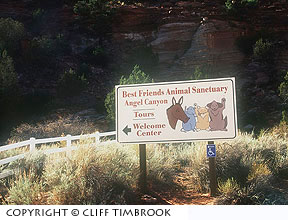
After my Utah workshops in April this year, I had an opportunity to visit a wonderful animal sanctuary called Best Friends in Angel Canyon near Kanab, Utah. I was so pleased by what I saw, I decided to do an interview for Apogee, and I asked Cliff Timbrook and Dr. Dorothy Riess, two workshop participants, to handle the photography for me. We faced challenging conditions, because we visited several animal compounds and saw a variety of animals. In addition, we didn’t have a lot of time in each area. To complicate the demands of the work further, the photographers needed to step away from the norm of lovely or cute animal portraits to illustrate my written words. Through their pictures, they would speak for animals that had been abused, abandoned, or were simply unwanted. Their images needed to tell a story as well as to invoke strong emotions
When you’re writing a photo story or when you’re planning to put together a group of photographs for a specific “story purpose” such as a slide program or article, there are specific actions you can take to make the job smoother and easier for yourself. And, if you do your work creatively, the results will be much more interesting than an “I-was-there-I-saw-that” group of images.
To prepare yourself for this kind of assignment, you need to do some thinking ahead of time … before you pick up your camera. For example, read about the history of the location or the purpose of the trip. Talk to people who’ve been in your target location or have had a similar experience. Do as much research as you can. However, sometimes advance research isn’t possible. Since my example was a spur-of-the moment decision, I didn’t have a chance to prepare. I seized an opportunity as it presented itself and took careful notes. Normally, I work alone. It can be difficult to act as both reporter and photographer. Having Dot and Cliff along to help was a special treat.
DECIDE ON YOUR STORY STRUCTURE
How do you start to prepare a photo/text package? It’s extremely important to consider the structure you’ll want to use. It’s almost like constructing a building. You need a foundation (research), a framework (basic facts), and finishing details (good writing, strong images, and small details). Remember; until your final draft is set in type, everything is flexible and can and should be changed if you can make it better. Begin by asking simple questions such as the basic five “W’s” of journalism—the Who, What, Where, When and Why questions about the place or experience.
Next, make lists of things that you saw or did or want to talk about. After your experience, you need to add more facts to your list. They’ll form the structure of your story. Try to think of other questions that you could answer in your story. Some general questions might include:
· What is the main question (or questions) you want to answer for your reader or listener?
· What information does your reader need to know to understand the area, people, place, and purpose of the location?
· How can you present the experience so that your reader will want to go to the location?
· What are the special features that made a real impression on you?
GETTING STARTED
It’s sometimes difficult to get started with the actual writing of the story. Occasionally, you can almost see the opening paragraph when you’re beginning to work. At other times, the idea for the opening comes to you during or even at the end of your writing period. Remember; you don’t have to write the beginning at the beginning. Start wherever you feel comfortable and rearrange things later on. If you feel blocked, move on to another section or answer another question you formulated earlier. Be flexible in how you approach your writing. Initially, it’s more important to get your facts on paper than it is to polish one paragraph at a time.
Using your images to direct your story is another way to make the structure strong and make the writing process easier. To begin, examine your images and edit them. Select only the technically best ones before you move on to the next step. Here are some suggestions designed to give you ideas:
1. Organize your images. Perhaps you want to detail the events as they took place, or perhaps you want to group images that are alike–regardless of the order in which they were taken. For example, in a travel package, rather than talking about the flowers in each of the different locations, you might want to have a “botanical section” in your story. You could talk about the flowers as a group. The story seems more organized that way.
2. Caption the images. As you look over your images, think about captioning them. A guideline for helping organize the information you might want to use is the old “5 –W’s” of reporting–who, what, where, when, why. In beginning journalism classes, they teach the 5-w’s. If you can gather information by answering those five questions, you have a reasonably complete picture.
3. Write your story. One of the great tips that I was given when I first started doing photo/text packages was to write a story around the really good photographs that I had already taken. Your story becomes stronger if you have the perfect image to go with it.
4. Add important details. List every bit of information you can think of first without worrying about the sequence or the amount of information you have. This method may help you organize the information and get the basic facts down on paper. Next, flesh out the story with small details to add interest and color. (I usually try to write more than I know I’ll need. I find it easier to cut back on information than to have to scurry about trying to find one more fact.)
5. Make the story interesting. When you add details to your structure, keep in mind that everything must contribute to the strength, flavor, or color of the story.
6. Edit. If a piece doesn’t add to the final story, then brutally cut it out. No matter how much you love a photograph, if it isn’t a technically good one, drop it. Remember that you’re building strength into your story by adding the best writing you can do to the best photographs that you have available.
7. Read the story aloud. Test your writing ability by reading the story aloud. If you sound boring when you hear yourself read, chances are that your story will be boring to your audience, as well. Try to put yourself in the place of your audience. We’ve all experienced an overlong lecture or slide presentation. Before it was halfway finished, you were wishing you were any place else. Remember those moments, and don’t do that to your audience.
8. Check for spelling and grammar. There’s nothing worse than seeing typos and errors in a text. Ask any professional editor, and s/he will tell you errors are a mark of someone who didn’t take the final step and make the writing spotless. This was a lesson I learned the hard way. It was my last term paper before my college graduation. I just didn’t take the time to edit carefully. My professor returned the paper to me with all of the typos and misspelled words circled in red and gave me twenty-four hours to turn in the corrected paper, or I would miss my graduation. You remember experiences like that.
9. Review and re-edit if necessary. It seems that there’s always one mistake that wants to slip past you. Someone you know who will be carefully and constructively critical of your work will be the best person to do this last review. Frequently, I have my sister review my work. She speaks softly but carries a large blue pencil. She’s merciless!
CAPTIONING YOUR PHOTOGRAPHS (Step 2 above)
Now that you’ve edited and organized your images, I want to walk you through the captioning of images (step 2 above). This is probably the most important beginning step in writing a story. I’m not going to write the story about Best Friends Animal Sanctuary for you, but you’ll see that if you caption your images properly, the story almost writes itself. Also, you’ll see that by building your story around strong images, your presentation becomes more interesting to the reader or viewer.
Best Friends Animal Sanctuary
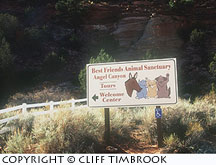
1. Welcome to Best Friends. Best Friends is the largest “No-kill “animal sanctuary in the United States. They shelter a minimum of 1800 animals at any one time. The purpose of Best Friends is to help bring about a time when there will be no homeless or unwanted animals being destroyed in shelters. Their goal is to know that every cat and dog born can be guaranteed a good life and a good home.
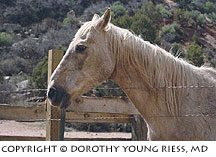
2. Best Friends is not just for cats and dogs. Horses, burros, wild birds, geese, rabbits, sheep, goats, pigs and other assorted critters are welcomed there. Many of the animals there have been abused, neglected, or abandoned. Now, in their old age, they live in comfortable surroundings. The horses have large fenced areas where they can wander. However, like most of the animals at Best Friends, they come right up to the fence for a little petting and love. Whenever possible, good homes are found for them as well as for the cats and dogs.
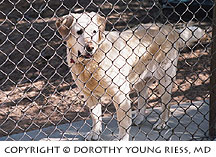
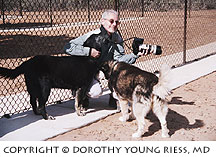
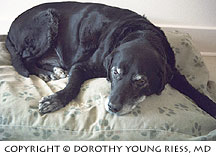
3. Dogtown. Each dog compound has several large runs and sleeping quarters so the animals can be segregated from one another, if necessary. Special care and love is offered to older dogs. All have soft beds inside and access to the runs. Volunteers frequently walk the dogs to help socialize them for adoption. Whenever possible, the goal is to find each animal a good and loving home. When that isn’t possible, the dogs are allowed to stay and live a good life in the sanctuary.
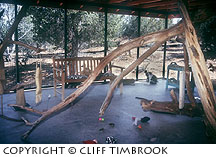
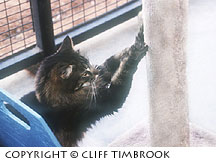
4. Cat “motels” have indoor and outdoor play areas. The cat areas are protected and have soft beds, climbing and scratching trees, plus lots of toys and playthings. Staff and visitors make sure the cats have lots of attention.
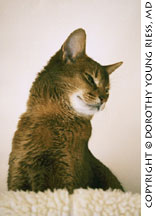
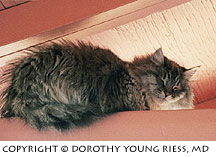
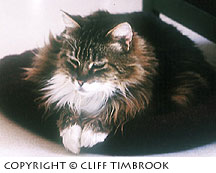
5. Contented kitties take naps on pillows, beds, or even rafters.
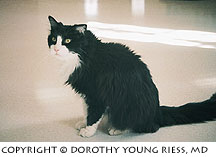
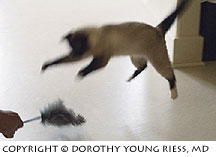
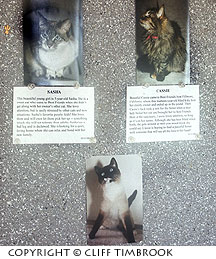
6. Benton’s House,” the very special TLC cat care quarters. Benton’s house is headquarters for cats with special needs such as medical problems. We met a couple of cats with neurological disorders stemming from birth. However, their disorders never stopped them when a feather was involved.
Our ”tour guide” in Benton’s house was a kitty that had been blind since birth but had no trouble showing us around. Although these animals may have medical problems, they are adoptable.
Special bulletin boards placed in all of the animal quarters have photos of the animals, their names and information about them.
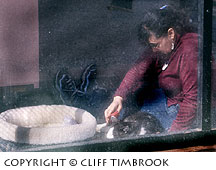
7. Volunteer programs are essential. Volunteers assist the staff in many ways by participating in making the animals’ lives better. They may walk dogs, groom cats, feed or clean quarters, and offer all the animals special love.
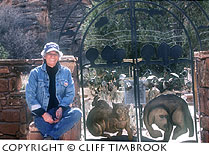
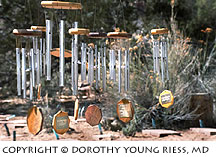
8. Angel’s Rest … a special spot. When the time has come for a beloved pet to die, Best Friends has set aside a memorial/cemetery called Angel’s Rest. When you stop at Angels Rest, a symphony of wind chimes greets you. Then, stepping through the magnificent gates created for Best Friends by founder and artist Cyrus Mejia, you see the garden of wind chimes and the special statuary and markers that commemorate the animals that touched someone’s heart
USING YOUR PHOTOGRAPHIC SKILLS TO MAKE THE WORLD A BETTER PLACE:
Hopefully, all of this brought some ideas to your mind. For those of you who have time to volunteer, you may want to consider coming to Utah to visit or even to be a part of the Best Friends volunteer program. Although you might not be able to stay long, you could take some good ideas home. Visit your local shelter to see if you could make a difference there, as well. Animals need love and loving care so much.
But, photographers have unique abilities. As photographers, we need to ask what are some of the other things we could do to assist the many charitable associations we want to support? One idea is to volunteer your skills as a photographer. Perhaps your favorite charitable organization needs good images for their bulletins or newsletter.
In the animal world, photos are often needed to help encourage adoptions or to be auctioned off as fundraisers. Within other organizations, it’s possible to use your skills or images of a wide variety of subject matter to help with fund-raising. Offer your images to organizations as door prizes or even to enhance their office décor. The workers need something special to remind them of the good they’re doing. Use some imagination to see how you and your photography can make a big difference in many lives.
by Noella Ballenger

Leave a Reply